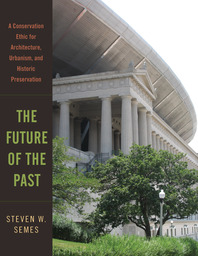
The Future of the Past
A Conservation Ethic for Architecture, Urbanism, and Historic Preservation
5 January 2010
Territory Rights — Worldwide.
Description
A comprehensive and eloquent argument for “new traditional” architecture that preserves the style and character of historic buildings.
Reviews
"The Decade’s Most Important Book on Urban Architecture….With the publication of this volume, Steven Semes has vaulted into the first rank of contemporary architectural critics and preservation theorists…. should be must reading for all preservationists and people serving on landmark commissions and design review boards." — Traditional Building
"Will we ever agree on the future of the past? Probably not. However, with this compelling and accessible study, Steven W. Semes has taken a major step forward towards that illusory goal. . . . [A] thought provoking book." — APT Bulletin: Journal of Preservation Technology
"Semes mounts the most thorough attack I’ve ever read on the anti-tradition stance of many architectural and historic preservation professionals. The need for this book is intense….Everyone, including general readers, will find this book’s many illustrations, with their pithy captions, illuminating. This book should help the confused 21st century to create and maintain places of lasting value." — New Urban News
"[P]resents a persuasive case against the preservation ethic of oppositional styling; that is, the argument that new additions to historic buildings must be deliberately un-period so as not to be confused with the existing, ‘authentic’ section of the building. Semes illuminates the error of this way of thinking, and walks us through a history of architecture and preservation in the process." — Planetizen.com
"[A] stirring and passionate call to get historic preservation right by respecting the past without making it sacrosanct." — Civil Engineering
"[A] clear and comprehensive argument….adds significantly to the discussion, one that should continue as an important topic within the historic preservation, urban planning, and architecture professions." — AASLH History News
"[T]houghtful and thought-provoking….a must-read for those who care for and care about our architectural heritage." — Sacred Architecture
"[B]eautifully illustrated….comprehensive….[N]eeds to be understood and followed by professional architects and preservationists; most of the lay public, which likes old buildings and neighborhoods, is already on Semes’ side." — The Commercial Dispatch
"With The Future of the Past, architect Steven W. Semes has planted his foot hard in the tense area between architectural innovation and historic preservation…[R]aises questions that everyone involved in historic preservation needs to think about. Semes thus deserves credit for tackling a complex issue that is playing out in myriad ways all over the world." — Kathleen Corbett, Traditional Dwellings and Settlements Review
"[S]peaks in common-sense terms, it is didactic and approachable, and the laymen who are in the trenches…will find powerful ammunition in it." — American Arts Quarterly
"Full of well illustrated examples, drawings, and photographs of the results of both approaches, this volume is likely to take up important space in future discussions." — Book News
"Mr. Semes makes a compelling argument; hopefully is does not fall on deaf ears." — Portland Book Review




